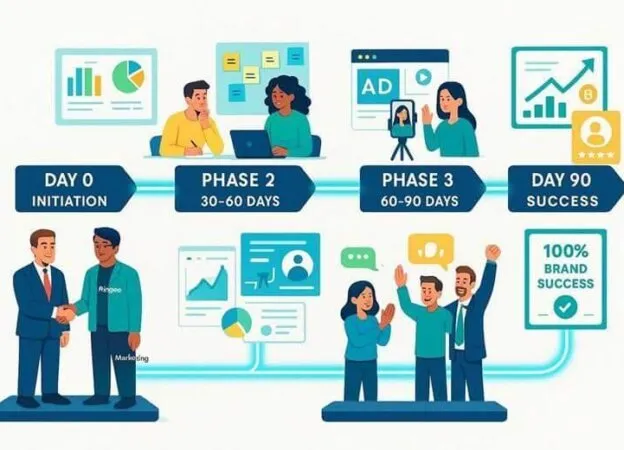Customer engagement is an essential part of any business strategy. Achieving a successful customer relationship involves creating relationships that are mutually beneficial and rewarding for both the company and its customers. Maintaining a steady customer engagement strategy helps to keep your customers coming back, encourages loyalty, strengthens brand trust, and fosters the development of stronger relationships with your consumers—all important factors in driving positive growth for your organization.
To build a strong foundation for customer engagement, it’s critical to create a comprehensive strategy that considers all aspects of the interaction process between you and your buyers. This guide will take you through all steps needed to develop such as strategy; outlining hot topics like understanding buyer personas, refining communication tactics across both online and offline channels, generating campaigns tailored to fit specific goals while optimizing resources, leveraging automation tools when possible —and much more!
Identify Your Target Audience and Their Needs
Knowing your target audience and what drives them to connect with your brand is essential to creating a successful customer engagement strategy. Doing research throughout the process will help you understand who your target customers are, what their expectations are, and how you can use this information in your strategy. Without an accurate profile of who you’re aiming for, it’s easy to waste valuable resources on inefficient campaigns or messaging that don’t resonate with customers.
By taking the time to identify their needs and create messaging tailored specifically for them – with thoughtful content that speaks directly to their interests, priorities, and values – you can develop an engagement strategy that resonates with your root audience and encourages loyalty.
Establish Clear Goals for Your Customer Engagement Strategy
Crafting an effective customer engagement strategy begins with establishing clear goals. Begin by considering your long-term objectives and decide what matters most – return on investment, increased brand loyalty, expanding market share, etc. It’s important to develop measurable goals that can be tracked and evaluated over time. Then focus on selecting the right tools, messages, and channels for your current needs as well as any potential changes in the future. Finally, create a plan for how to track engagements, analyze trends and make timely adjustments accordingly. By taking a proactive approach to planning and building a solid customer engagement strategy, businesses will be well-equipped with sustainable success.
Understand the Different Touchpoints of Customer Engagement
Understanding the different touchpoints of customer engagement is a critical piece of building a solid strategy. Each customer has a unique journey and experience with a brand, so it’s important to consider what those touchpoints might look like to create an engaging approach. From online chats and emails to physical mailers and ads, there are many ways to communicate and reach out to customers. Businesses need to identify the best methods for each step of the process to foster stronger relationships and improve customer loyalty. Additionally, by paying attention to your company’s tone of voice you can ensure that all engagements are authentic, relatable, and appealing!
Create a More Personal Experience
Whether it’s over the phone, email, or live chat, having someone readily available to assist customers can create a more personal experience. By leveraging available customer service technologies such as modern contact center solutions businesses can quickly respond to inquiries and facilitate an effective resolution. Additionally, agents can help increase customer loyalty by actively engaging with them to develop long-term relationships built on mutual trust and understanding.
According to the folks from Grypp – a customer engagement platform helping to automate and optimize customer service interactions – one of the most important elements for successful customer service is a visual customer engagement solution. This type of technology can be implemented to offer customers an interactive experience with visuals and voice-based interactions, providing a more personal experience than traditional communication methods.
Create a Responsive Website with an Intuitive User Experience
Creating a website that looks great, is easy to navigate, and responds well to different screen sizes, can be no small feat. To ensure your customers enjoy the online experience your business has to offer, building a website with an intuitive user experience should be at the forefront of all website creation endeavors. By emphasizing ‘responsive’ design principles that are both aesthetically pleasing and accommodating to multiple device types, you can create a robust customer engagement strategy that cultivates trust and expands your audience.
With the right approach, even complex technical considerations and procedures can be made easier for creators—so don’t get discouraged by the prospect of creating a responsive website with an intuitive user experience. Embrace it and make it work for you!
Leverage Content Marketing to Increase Reach and Engagement
Leveraging content marketing is an effective way to increase reach and engagement with your customers. Developing a strategy should be based on understanding what your customers need and value, as well as how they like to consume content. In addition to analyzing the topics that interest your audience, you could consider activities such as writing blog posts and creating engaging visuals, or posting social media stories and videos that are of immediate relevance to them. Additionally, an effective way of gaining more exposure for your content is by working with influencers and leveraging their audiences to get more eyes on it.
Finally, don’t forget to make use of SEO techniques to ensure that your content appears high on search engine results pages; this will help you maximize the number of website visits from potential new customers.
Utilize Social Media Platforms to Foster Interactions
As a marketing tool, social media can be an incredibly powerful tool when used correctly. Leveraging the various platforms available to create meaningful interactions with your customer base is an essential element of any successful customer engagement strategy. This type of content drives conversations between brands and their followers, allowing businesses to tap into their target markets in a way that was previously impossible or highly limited.
Once it’s set up, engaging with customers through social media is often low-cost and can also serve as a form of free advertising by allowing customers to share stories or individual experiences. So make sure to invest the time and resources necessary to carefully build out this critical aspect of your customer engagement strategy.
Automate the Customer Journey to Make the Process Easier
Automation can help streamline and expedite customer engagement processes, enabling faster response times. This is especially useful if your business has a large customer base that demands swift responses due to high levels of competition or other factors. Additionally, automation allows businesses to deliver personalized messages for different target demographics, making the entire customer journey feel more human and tailored to their individual needs.
Investing in this technology is a great way to ensure that your customers enjoy a smooth and efficient engagement process every step of the way. Depending on the size of your business, there are several customer engagement technology solutions available so make sure to shop around to find the right one for your needs.
Offer Rewards for Customer Loyalty
Rewarding loyal customers with exclusive offers or discounts can help foster loyalty and encourage repeat engagements. This could be as simple as offering a discount code on specific items or services, providing memberships with additional perks, or sending out emails when new products are available. Additionally, you could use reward programs such as loyalty points that can be used for future purchases- these not only keep existing customers engaged but also attract potential new ones. Finally, don’t forget to thank your customers for their business. A simple ‘thank you’ message with a small token of appreciation goes a long way in building loyalty and making customers feel special.
Track and Analyze Your Results
The final step of any customer engagement strategy is to track and analyze your efforts. By taking the time to review real-time data, you can gauge how effective your strategies have been and make changes or adjustments as needed. This will allow businesses to identify trends in customer behavior which can help them better understand their target markets and eventually fine-tune their engagement strategies for maximum efficiency.
Additionally, tracking analytics helps businesses measure progress, allowing them to identify opportunities for improvement as well as successes that can be replicated. As a result, tracking performance is an important element of any successful customer engagement program so don’t forget to take the time to review the data regularly.
Review and Revise
Finally, it’s important to review and revise your customer engagement strategy regularly. As customer needs and preferences evolve, businesses must be prepared to adjust their strategies accordingly to remain competitive. Additionally, with the fast-paced nature of the digital world today, staying ahead of trends is essential for long-term success. So be sure to evaluate your current approach periodically so that you can stay one step ahead of the competition!
Even if your strategies are working, it’s important to stay informed and make necessary changes as needed. Not only will this help ensure business success, but it will also help you deliver a quality customer experience that keeps customers coming back for more!
In summary, a customer engagement strategy is essential to the success of any business. By identifying your target audience and understanding their needs, you can craft a solid customer engagement strategy that will help you reach and exceed your goals. To ensure your strategy is successful, create a website with an intuitive user experience and leverage content marketing to increase reach and engagement. Additionally, don’t forget to use popular social media platforms such as Facebook and Twitter to foster interactions between customers and your brand. When done right, customer engagement can be a powerful tool that increases customer loyalty which in turn leads to greater success for any business.



